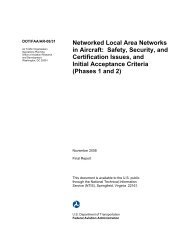Published Report (DOT/FAA/CT-94-36)
Published Report (DOT/FAA/CT-94-36)
Published Report (DOT/FAA/CT-94-36)
Create successful ePaper yourself
Turn your PDF publications into a flip-book with our unique Google optimized e-Paper software.
1 ACC X 8 WCB's x 102 Itat risk" WCB x 3 APP<br />
25 mill APP 1 Itat risk" WCB 5 TCV's 1 Triple APP<br />
x 1 TCV x 100 30-Desree BL - 9.8 30-Desree Blunder<br />
2 ACC 1 WCB 10,000 Triple APP<br />
Therefore, about ten 30-degree blunders per 10,000 triple<br />
parallel simultaneous approaches could be tolerated for the risk<br />
of the operation to meet the target risk level.<br />
The occurrence of blunders during parallel approaches has<br />
remained undocumented. Anecdotal evidence has indicated that<br />
blunders do occur during simultaneous approach operations.<br />
Knowledgeable representatives from the <strong>FAA</strong> have indicated that<br />
blunders may occur as often as one or two times per 10,000<br />
simultaneous approaches. Therefore, based upon the data<br />
collected in the simulation, the proposed triple parallel<br />
approach operation at DIA meets the current high level of safety<br />
found in approach operations. Additional detail about the risk<br />
analysis of blunders appears in appendix L.<br />
4.9 MPAP TWG STATEMENT.<br />
In their Operational Assessment (appendix K), the MPAP TWG<br />
stated, "Based on the established test criteria, the controllers<br />
met the simulation objective. The arrival monitor positions in<br />
the simulation proved to be operationally effective and feasible.<br />
The test controllers participated in the simulation as though<br />
they were controlling live traffic. Their attention and<br />
dedication was critical to the success of the simulation.<br />
Based upon the results of the simulation, the TWG believes that<br />
the proposed triple simultaneous ILS approaches at DIA are<br />
acceptable, achievable, and safe with the final monitor aid (FMA)<br />
system and an appropriate radar system, such as a Mode S<br />
monopulse system or an ASR-9 radar system enhanced to provide<br />
improved target resolution capabilities."<br />
5. DISCUSSION.<br />
This discussion covers the sirnulation findings with respect to<br />
the criteria set for the DIA simulation: 1) the number of TCV's<br />
relative to the total number of "at risk" blunders; 2) frequency<br />
of NTZ entries and NBO's; 3) operational assessment; and 4) risk<br />
assessment.<br />
5.1 TEST CRITERION VIOLATIONS.<br />
During the simulation, only two Itat riskt1 blunders resulted in<br />
TCV's. Since there were 186 "at riskt1 blunders generated during<br />
the simulation, the controllers were able to successfully resolve<br />
98.9 percent of all Itat risk" blunders. This 98.9 percent<br />
43

















